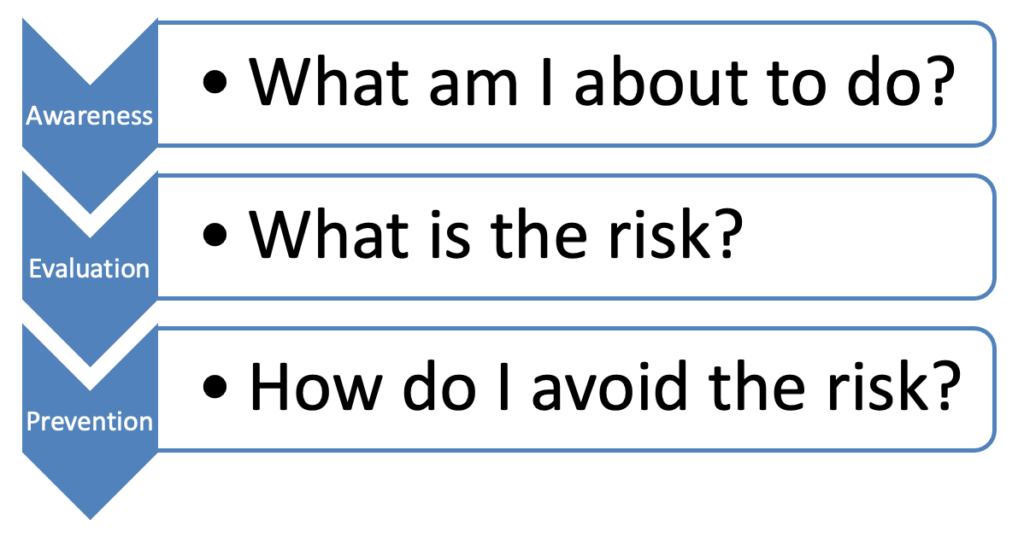What is situational awareness?
- Understanding and being present in your environment
- Assessing the threats that could harm you or someone else
- Being aware of what is happening around and to you
- Preparing for the task you are about to perform
- Making decisions to safely accomplish the task.
By taking the time to think through performing a task safely, a decision can be made about how to proceed. This will also ensure that you are taking action to protect yourself and those around you.
Situational awareness is as simple as thinking through three questions. However, it also requires continuous monitoring of the environment as the task is performed so proper reactions will keep you safe.
These examples all include common tasks for an outdoor industry employee and demonstrate how best to implement situational awareness.
Example #1
What am I about to do? Get a ski boot box from the top shelf in the storeroom.
What is the risk? The box and boots weigh approximately 25 pounds so manual handling, by itself, is not a risk; however, reaching above shoulder height is outside the power zone and could cause injury to the shoulder or the low back. If not properly handled, the box may fall from the top shelf and strike you or someone else walking through the back room and damage the product.
How do I avoid the risk? Instead of climbing on the shelf unit to access the item on the top shelf, use a step stool/step ladder to get closer to the box. Once the top shelf is above waist but below shoulder height, the helmet box can be pulled toward the front of the shelf and safely removed. To maintain three points of contact (two hands, one foot or two feet, one hand), you might need to set the box on the mid-level shelf to free your hands while climbing down the steps.
Example #2
What am I about to do? Deliver skis to a customer staying at a hotel 30 miles away from the store.
What is the risk? It is nighttime, the hotel is in an unfamiliar location, snow and ice conditions are present on mountain roads.
How do I avoid the risk? Inspect the vehicle (tire tread and pressure, lights, brakes, flashers) to ensure it is roadworthy. Before proceeding, set the GPS navigation and adjust the audio volume so verbal directions are clear – do not use the GPS map function. Remove all distractions (phones, food, and materials on the dashboard) from inside the vehicle and focus on driving. Reduce speed and continue to adjust driving behaviors based on road conditions.
Example #3
What am I about to do? Set up a merchandise display.
What is the risk? Theft is on the rise for high valued items or commodities such as bikes, skis, climbing gear and snowboards.
How do I avoid the risk? Consideration should be given to eliminate window displays of high value items, replacing them with posters or other marketing materials to prevent smash and grab type incidents. Merchandise display of bikes, skis and snowboards should be in a fixed rack and equipped with locking devices. Each individual product should be securely fastened to the rack, allowing a Salesperson to remove one item at a time for customer access. The locking device should be in view so that a shoplifting incident or theft is deterred. Displays of valuable items should be kept away from store entrance or exits but in full view of store employees.
Example #4
What is about to happen? A customer is trying on a pair of ski boots.
What is the risk? The lack of friction between the bottom of the ski boot (a hard plastic) and a hard surface floor will result in a slip and fall.
How do I eliminate the risk? Ensure that ski boots are tried on in designated areas only – where the floor is covered with carpet or have a sufficient amount of walk-off mat. Potential buyers of ski boots should not be allowed to walk beyond this designated area and should be observed during the entire ski boot fitting process to ensure that there is no wandering beyond the slip resistive area.
Example #5
What is about to happen? A customer is entering the store while wearing ski boots.
What is the risk? The lack of friction between the bottom of the ski boot (a hard plastic) and a hard surface floor will result in a slip and fall.
How do I eliminate the risk? Caution signs should be posted at the entrance doors – warning of the slip and fall hazard of wearing ski boots inside the store. A sufficient amount of walk-off matting should be present during snow months. Based on an average person stride (30”), at least 30 feet of matting should be present to sufficiently remove the snow melt from the bottom of the boot. This length of matting should be increased if the distance to a check-out counter is greater than 30 feet to provide extra protection. The condition of the mats should be constantly monitored and the mats replaced when they become saturated with moisture. The edges of the mat should be beveled for easy transition from threshold to top of mat and the mat should lay flat on the ground.
Example #6
What is about to happen? An adult enters the store with a young child.
What is the risk? The adult becomes distracted during their shopping experience and the child begins to climb on a ski rack. The child could be injured by climbing onto the rack. The rack could be pulled down onto the child or the skis could be damaged.
How do I eliminate the risk? Politely ask the adult to remove child from rack and indicate concern for child’s safety. Review company policy for action to be taken if there is no cooperation.

